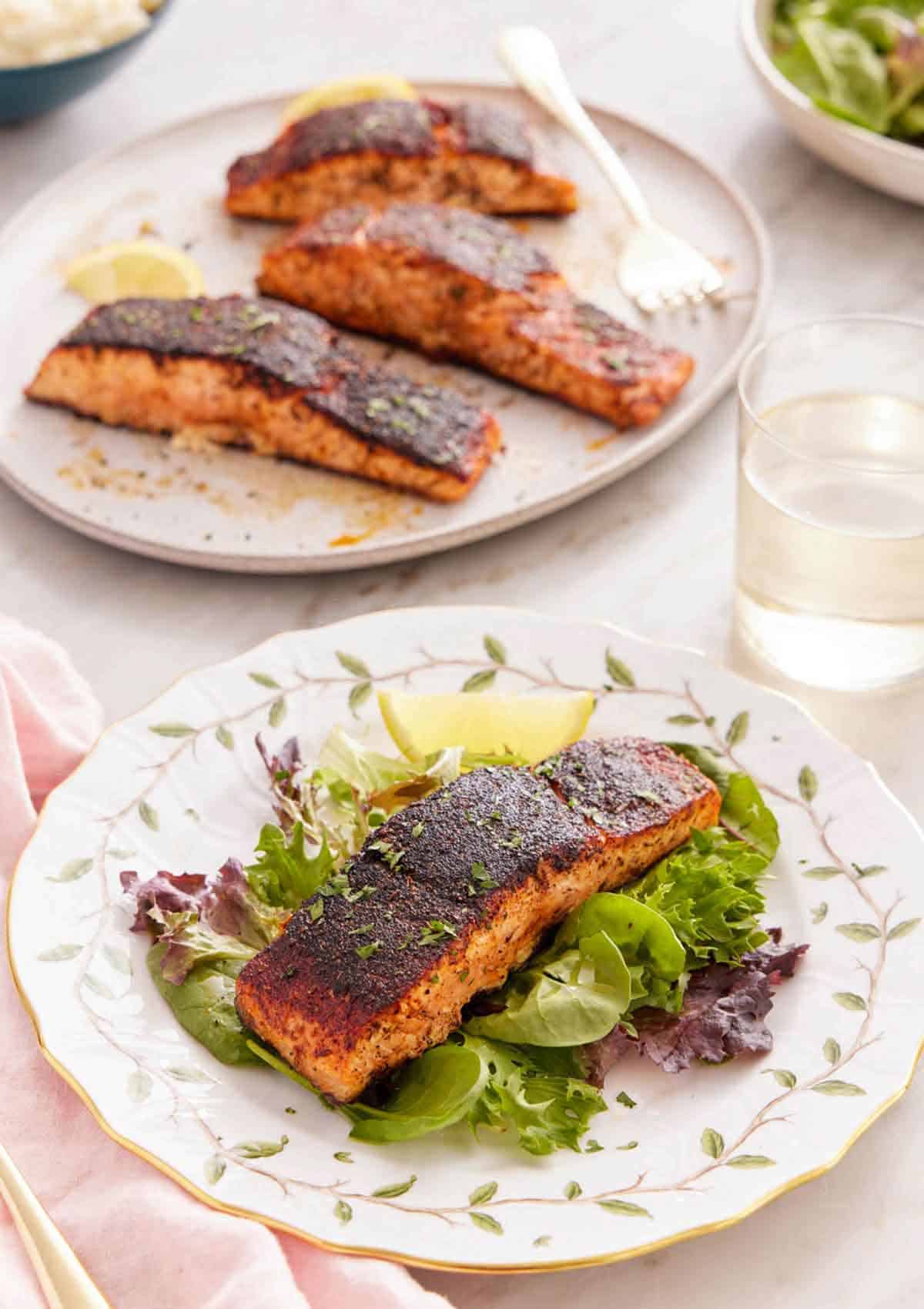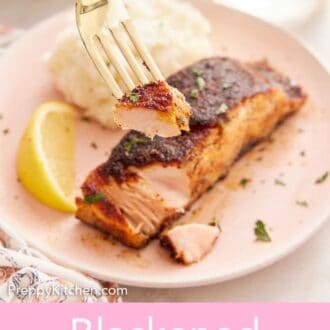For a simple but delicious dinner, try this delightful blackened salmon recipe! It only takes a couple of minutes to prepare, and once the salmon hits the hot pan, the fish is ready in 10 minutes or less. Seared to perfection, each bite of salmon is flaky, tender, and moist.
You don’t need a ton of ingredients to make this, and you probably have all the spices in your cabinet already. Enjoy it as a quick weeknight dinner, or serve this restaurant-quality salmon for some guests!
Even better, this salmon recipe pairs deliciously with various sides. You’ll love the countless ways to serve this, from roasted vegetables to salad, rice or pasta, and even fruit! Try serving this salmon with one of my delicious side dish recipes such as my roasted potatoes recipe, roasted carrots recipe, or my mango salsa recipe.
What You Need to Make This Recipe

Seasoning — I use a combination of paprika, salt, onion powder, garlic powder, dried oregano, dried thyme, and black pepper. A blend will ensure you have a flavor-packed crispy crust on your salmon.
Salmon — any type of salmon will be perfect for this recipe but try to get the best quality fillets. Look for salmon that is firm and has a vibrant color. If you are using frozen salmon, make sure they are fully thawed before you season and cook them.
Oil — I use olive oil, but you can use any neutral oil with a high smoke point, such as canola or grapeseed oil.
How to Make Blackened Salmon

1. In a small bowl, stir together the paprika, salt, onion powder, garlic powder, dried oregano, dried thyme, and black pepper.
2. Brush the top of the salmon fillets with 1 tablespoon oil.

3. Sprinkle generously with the spice blend.
4. In a large cast iron skillet over medium-low heat, add the remaining 1 tablespoon of oil. Cook the salmon, spice-side down, until browned, 4 to 6 minutes. Flip the salmon and continue cooking until the fish is cooked through, about 4 minutes for medium-rare. Remove from heat. Sprinkle with parsley and serve with lemon wedges.

Pro Tips for Making This Recipe
- Make sure the cast iron skillet is hot before adding the salmon to it. A hot pan ensures you get a beautiful crust on the salmon.
- A cast-iron skillet is the best ideal for cooking blackened salmon. Cast iron heats up evenly and retains heat well.
- If you have a fish spatula, that’s perfect for this recipe. A fish spatula is thin and flexible, allowing you to lift and flip the fish without damaging it. If you do not have one, a large thin spatula will work, just be careful while flipping!
- Don’t skimp on the seasoning. Sprinkle a generous amount of seasoning on each fillet to get a deliciously crispy crust on your fish.
- For the best crust and to prevent tearing of the fillets, avoid moving the salmon as it cooks. You can gently lift a corner of the fish to check if the crust has blackened but be patient and allow the salmon to sear undisturbed.
- If you’re unsure if the salmon is done, you can use a cooking thermometer to check the internal temperature. The FDA recommends that salmon be cooked to 145°F but keep in mind that residual heat from your skillet will continue to cook the salmon as it rests, so make sure to remove the salmon from the heat immediately.

Frequently Asked Questions
When you prepare the salmon, pat it dry with a paper towel if there is moisture on the fish. This will ensure the oil and seasoning adhere to the fish.
You can use skin-on or skinless salmon fillets! There’s no need to remove the skin as it crisps up wonderfully and helps hold the salmon together.
Blackening salmon is a cooking technique where salmon fillets are generously seasoned with a spice rub and then seared in a hot skillet to create a black, crispy crust with a smoky flavor on the exterior.
If you have leftovers, allow the fillets to cool to room temperature before transferring them to an airtight glass container. Store in the refrigerator for 2 to 3 days.
If you’ve tried this Blackened Salmon recipe, then don’t forget to rate the recipe and let me know how you got on in the comments below, I love hearing from you!

Blackened Salmon
Equipment
- Small bowl
- Large skillet
Ingredients
- 1 tablespoon paprika
- 1¼ teaspoons salt
- ½ teaspoon onion powder
- ½ teaspoon garlic powder
- ½ teaspoon dried oregano
- ½ teaspoon dried thyme
- ½ teaspoon ground black pepper
- 4 salmon fillets skin-on or skinless (6 ounces/170g each)
- 2 tablespoons olive oil
- 1 tablespoon chopped parsley
- Lemon wedges for serving
Instructions
- In a small bowl, stir together the paprika, salt, onion powder, garlic powder, dried oregano, dried thyme, and black pepper.
- Brush the top of the salmon fillets with 1 tablespoon oil and sprinkle generously with the spice blend.
- In a large cast iron skillet over medium-low heat, add the remaining 1 tablespoon of oil. Cook the salmon, spice-side down, until browned, 4 to 6 minutes. Flip the salmon and continue cooking until the fish is cooked through, about 4 minutes for medium-rare. Remove from heat. Sprinkle with parsley and serve with lemon wedges.
Notes
- Make sure the cast iron skillet is hot before adding the salmon to it. A hot pan ensures you get a beautiful crust on the salmon.
- A cast-iron skillet is the best ideal for cooking blackened salmon. Cast iron heats up evenly and retains heat well.
- If you have a fish spatula, that’s perfect for this recipe. A fish spatula is thin and flexible, allowing you to lift and flip the fish without damaging it. If you do not have one, a large thin spatula will work, just be careful while flipping!
- Don’t skimp on the seasoning. Sprinkle a generous amount of seasoning on each fillet to get a deliciously crispy crust on your fish.
- For the best crust and to prevent tearing of the fillets, avoid moving the salmon as it cooks. You can gently lift a corner of the fish to check if the crust has blackened but be patient and allow the salmon to sear undistributed.
- If you’re unsure if the salmon is done, you can use a cooking thermometer to check the internal temperature. The FDA recommends that salmon be cooked to 145°F but keep in mind that residual heat from your skillet will continue to cook the salmon as it rests, so make sure to remove the salmon from the heat immediately.















After checking this blackened salmon feast, I am off to the market to buy some salmon so I can make this fabulous recipe today!